We may receive a commission when you use our affiliate links. However, this does not impact our recommendations.
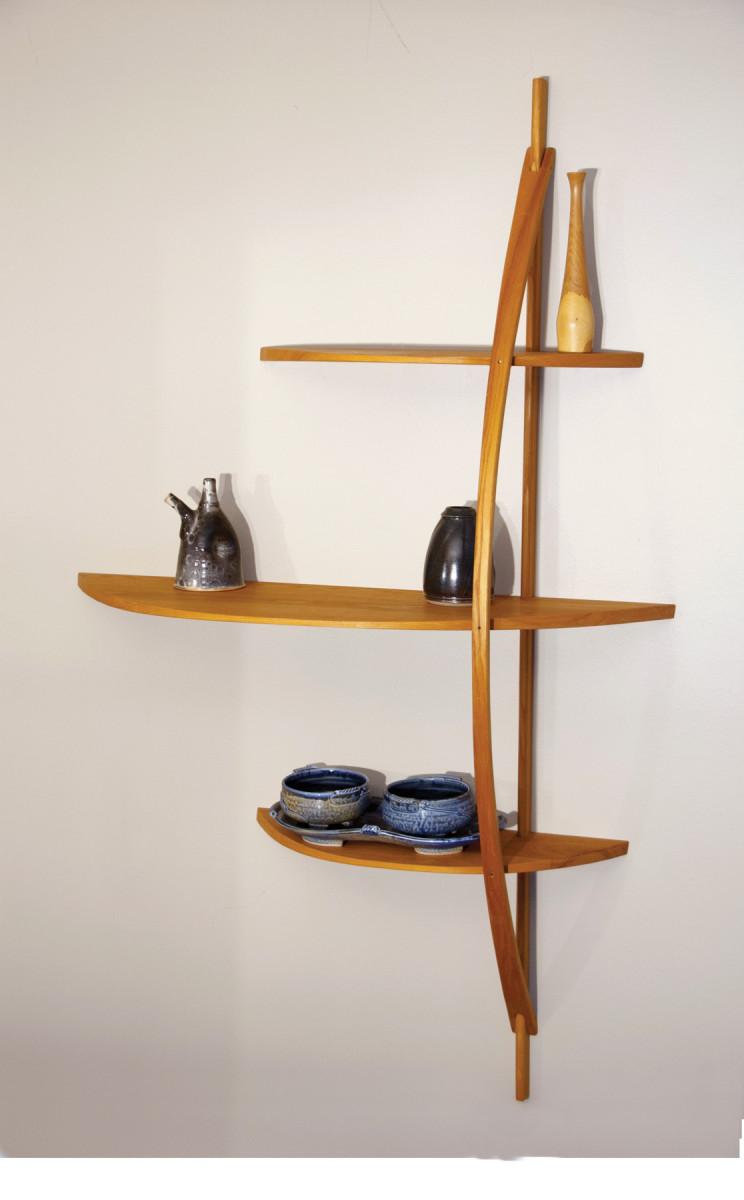
Delicate ‘hyperparabolas’ hang on a curve – then hang ‘magically’ on the wall.
When I saw a photo of a set of three rectangular shelves supported by a bow near each end, my reaction was that the bows deserved better shelves. These shelves are the result.
The shelves are seemingly floating on the wall with no visible means of support, so I’ll quickly explain the “tricks.” The backs of the shelves are supported by French cleats. The bow is made from bent laminations. The upright – the “bowstring” – is notched to fit over each cleat, and a slot is cut in each shelf to fit around it. Each joint – shelf to bow and bow to upright – is pinned with a short piece of 1⁄8” drill rod or steel rod from the home center.
The tops of the shelves are at about eye level, so it’s pointless to use highly figured wood; all you see are the edges. I’ve used both ash and cherry to make sets of bow shelves. Shown here in the step photos is cherry; the opening photo is a set of ash shelves.
These shelves are intended to display treasures, not to hold a printed encyclopedia set. They are light, and I wanted them to look light. The shelves are thick at the back to accommodate the French cleats, and thin at the front to lighten the appearance. The upright “string” at the back needs some strength, especially where it is notched to rest on the cleats. Its front edge is rounded. The bow needs to be wide at the ends to go around the upright, but narrow at the center. Everything but the shelf backs and upright are curved, and all the visible edges are rounded.
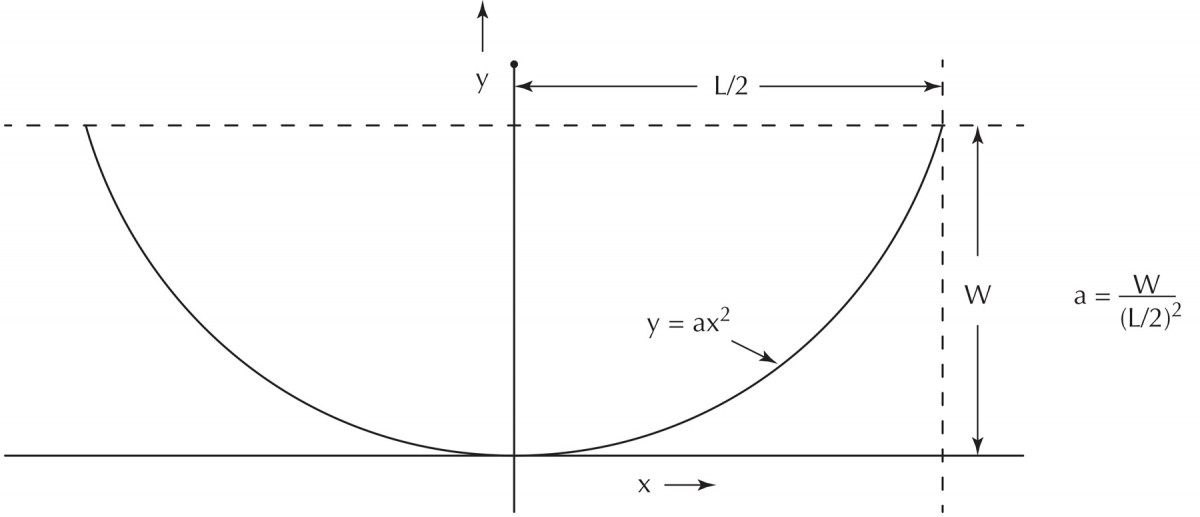
Parabolas. a= w/(L/2)^2
But the curves don’t stop there – the shelf fronts? A circular arc is too boringly uniform, and a parabolic shape for the shelves is too pointed – so I played with the parabola. A parabola is defined by the formula y=ax2 with x measured along the length from center, y is the depth of the shelf at that point, and a is a scaling factor.
Using a spreadsheet (“Plot Your Course”), I experimented with different values for the exponent 2 and looked at the shape of the curve on a resulting graph until I found a value I liked. A value of 2.5 looked best to my eye. (Note: The “hyper” in the title stems from this: A “hyperparabola” is a parabola with a higher exponential dimension than 2.)
 The curves of the bow, both the bend and the narrowing at the center, are too shallow for the shape to be important; I used a parabola for the bend. The center shelf will be attached near the middle of the bow; choose where the bow and shelf will meet. I used 8 5⁄8“. (We’ll find the crossing points for the small shelves later.)
The curves of the bow, both the bend and the narrowing at the center, are too shallow for the shape to be important; I used a parabola for the bend. The center shelf will be attached near the middle of the bow; choose where the bow and shelf will meet. I used 8 5⁄8“. (We’ll find the crossing points for the small shelves later.)
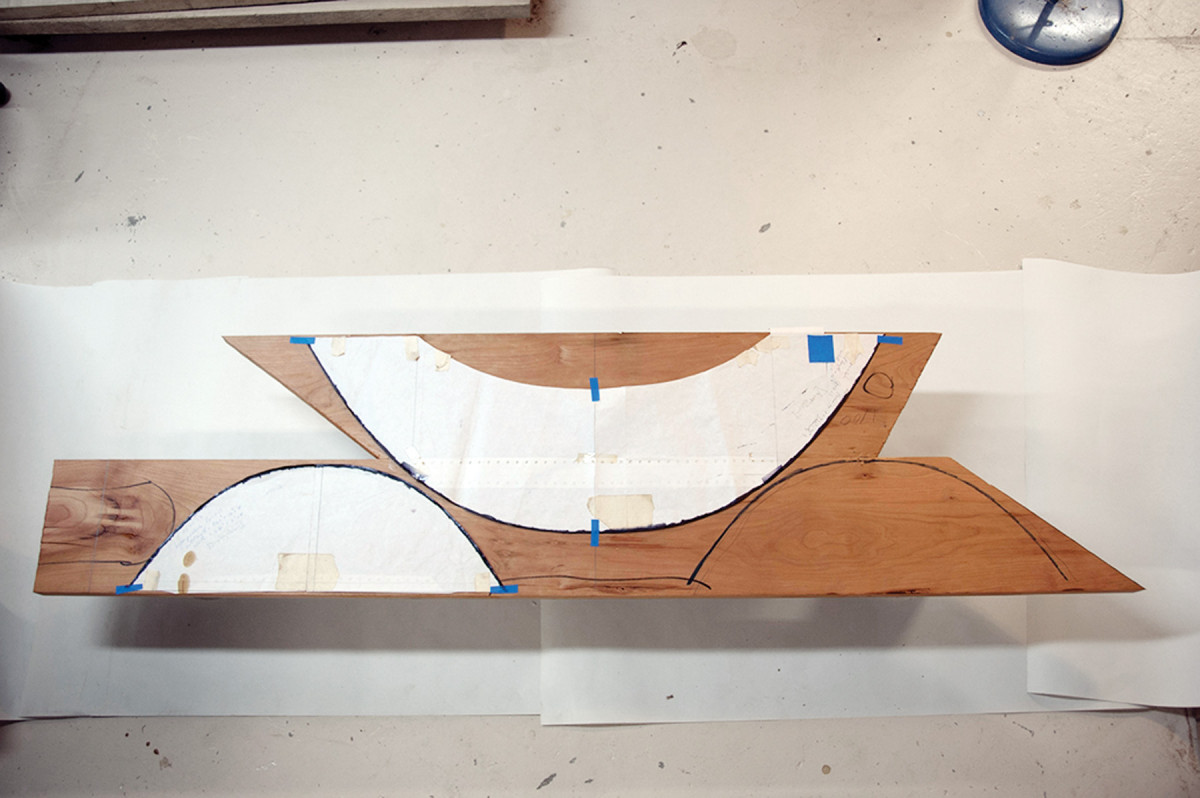
Shelf layout. By gluing together matching boards, I’m able to lay out my three shelves on one piece, then cut them apart at the band saw.
When viewed from the front, the bow is wider at the ends than at the center (the last spreadsheet column shows the negative space). Any smooth curve will do, but as with the bend, I chose a simple parabola.
Note: If you are making patterns from the spreadsheet calculations, I argue it is easier if you work in millimeters or decimal inches. A 12″ machinist’s rule with one side graduated in 10ths and 100ths is not expensive, nor is a dial caliper that reads in thousandths of an inch. Since I bought a dial caliper, I use it almost as much as my tape measure. I keep a table of decimal equivalent fractions hung up in a convenient place in my shop.
The dimensions in the spreadsheet include the 9⁄16” width of the cleat. One can either (allowing for the kerf width) rip the cleat pieces off the back of the shelf, or rip the cleats from a separate piece of wood. Then, make the shelves narrower to attach the cleat to the back.
Bow Shelves Cut List
No.ItemDimensions (inches)Material
t w l
❏ 1 Large shelf 3⁄4 x 11 x 32 Cherry
❏ 2 Small shelves 3⁄4 x 6 3⁄4 x 19 3⁄4 Cherry
❏ 1 String/upright 1⁄2 x1 x 48 Cherry
❏ 1 Bow 1⁄2 x 1 1⁄2 x 54 Cherry overlong
❏ 3 Cleats 9⁄16 x 1* Cherry
*Match length to shelves
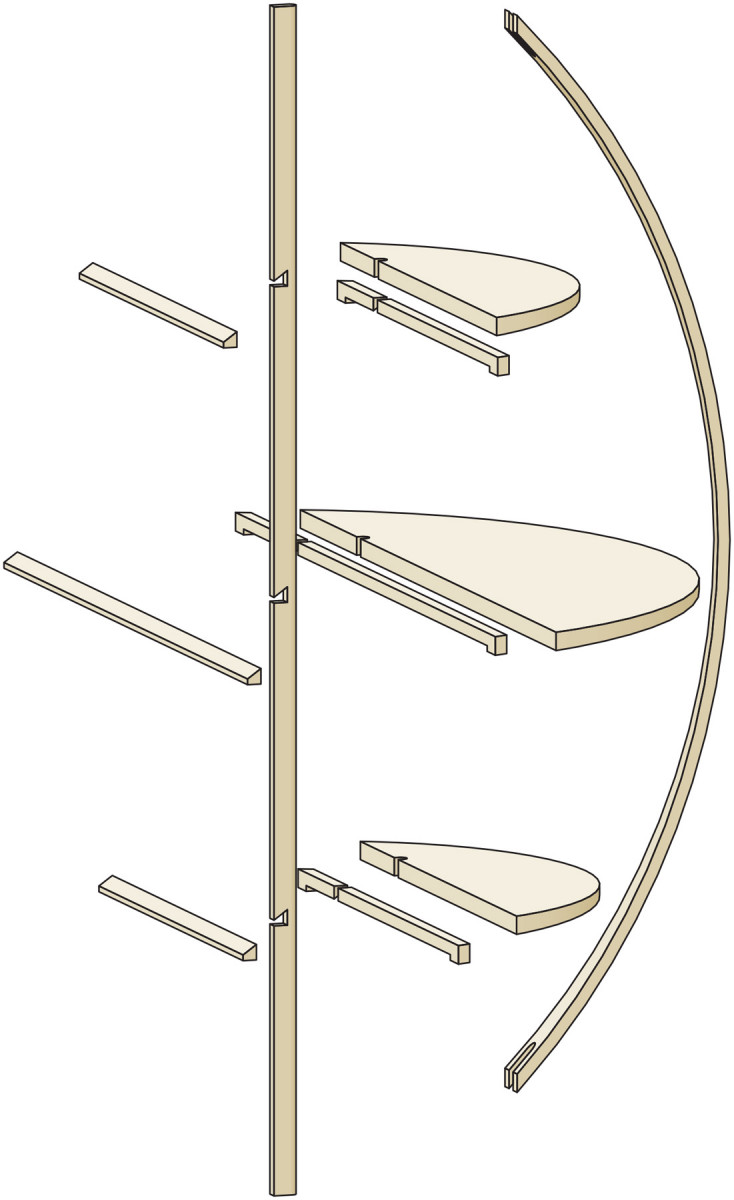
Exploded View
On the Shelves
So that the grain and color match at the front edges, I glued up a panel that allowed me to lay out all three shelves on one piece. After the glue dried, I cut them apart at the band saw, leaving “ears” on either end to accommodate planer snipe. Go ahead and joint the back edge of each shelf in preparation for gluing on its cleat.
I cut the French cleats – 9⁄16” wide by about 1″ thick (3⁄4” plus room for the kerf, and for planing to final size) – for each shelf out of wood that matches the shelves.
At my table saw, I ripped each cleat at a 35° angle instead of the usual 45° to give the relatively thin cleats additional strength, especially at the narrow edges.
Glue the upper part of each cleat to its shelf. Instead of clamps, I use 1″ finishing nails, drilling clearance holes in the cleat and pilot holes in the shelves. After the glue dries, temporarily attach the wall half of the cleats to their mates with hot glue so they can be planed as parts of the shelves.
To plane each shelf’s underside 3⁄8” thinner at the front than its back, attach a 3⁄8” batten to the top face of the shelf near its front edge. Make sure the battens are at least as long as their respective shelf piece (including the remaining “ears”). I use hot glue for the temporary attachment. Then run the shelves upside-down through the planer to reduce their front edges to 3⁄8” while leaving the rear edges a full 3⁄4“.
Pop off the battens and wall pieces of the cleats, then band saw each shelf to its final shape; clean up the curves using your preferred method and tools. (I used a spokeshave, followed by sandpaper.)
Now cut off the last inch or so of the wall piece of each cleat, and glue those to their mates at each edge of each shelf. This will help to disguise the hanging mechanism when the finished shelves are installed.
Knock down the sharp edges of all the cleat pieces so they will fit together easily, then put the shelves aside.
Add a Bow & Its ‘String’
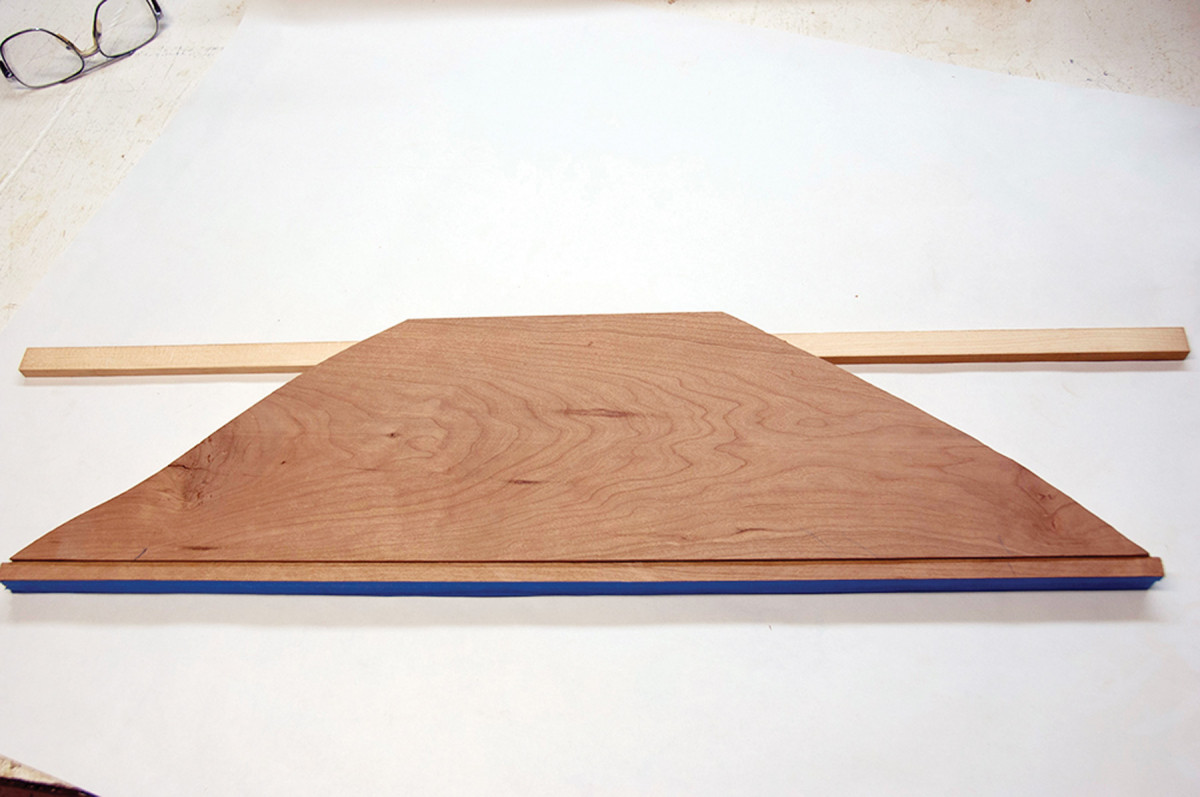
Ready to plane. Here’s the largest shelf, shown upside down with the “ears” still intact. Both halves of the cleats are attached at the back, and the 3⁄8″ batten is attached at the front to the top surface with hot-melt glue.
Cut and plane the upright (the bow’s “string”) to 1⁄2“-thick x 1” wide, but leave it a few inches overlong for now. (Once it is shaped, that excess will be cut off for a gauge.) Then round the front edge either by hand or with a router bit, and move on to the bow.
The finished width at each end of the bow will be 11⁄2“, so the lamination strips must be wider than that; I look for a piece of stock 13⁄4” to 2″ wide. For the strips that make up the bow lamination, choose a straight-grained piece of wood at least 54″ long, and make a diagonal pencil mark on its edge so the strips can be easily reassembled in order for grain matching.
Cut strips for the bow. I do this at the table saw, and cut them thick enough to plane away all the saw marks for a finished thickness of 1⁄8“. The bow is laminated from four strips, but cut a couple extra to allow for breakage, and so that you can use one (or more) as a clamping caul.
Surface both faces of each strip, running them through the planer on a pine sled.
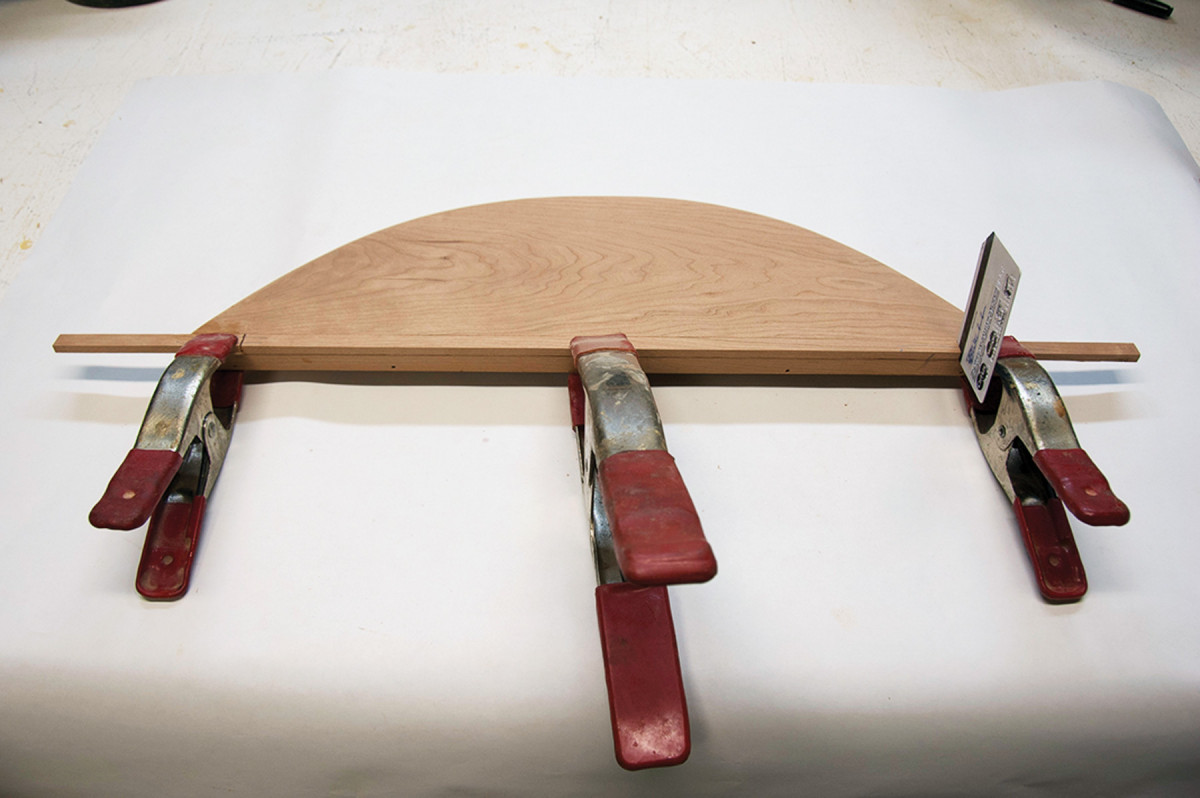
Less conspicuous. By gluing in place the last inch or so on each end of the wall half of the cleat, it will help hide the cleat when viewed from the side once the piece is on the wall. (In this picture, the ends still need to be flush cut to the shelf’s curve.)
The curve is gentle enough that only a male bending form is required. Mine is made from two 3⁄4” thicknesses of particle board, a bit longer than the bent length of the laminations, glued and screwed together.
Mark the form at the ends and center of the bow-to-be, and mark the laminations at their centers. Cover the form with strapping tape to keep glue from sticking to it.
But before reaching for the glue, do a dry-assembly. Using an extra lamination strip as a caul, start clamping at the center and work toward the ends.
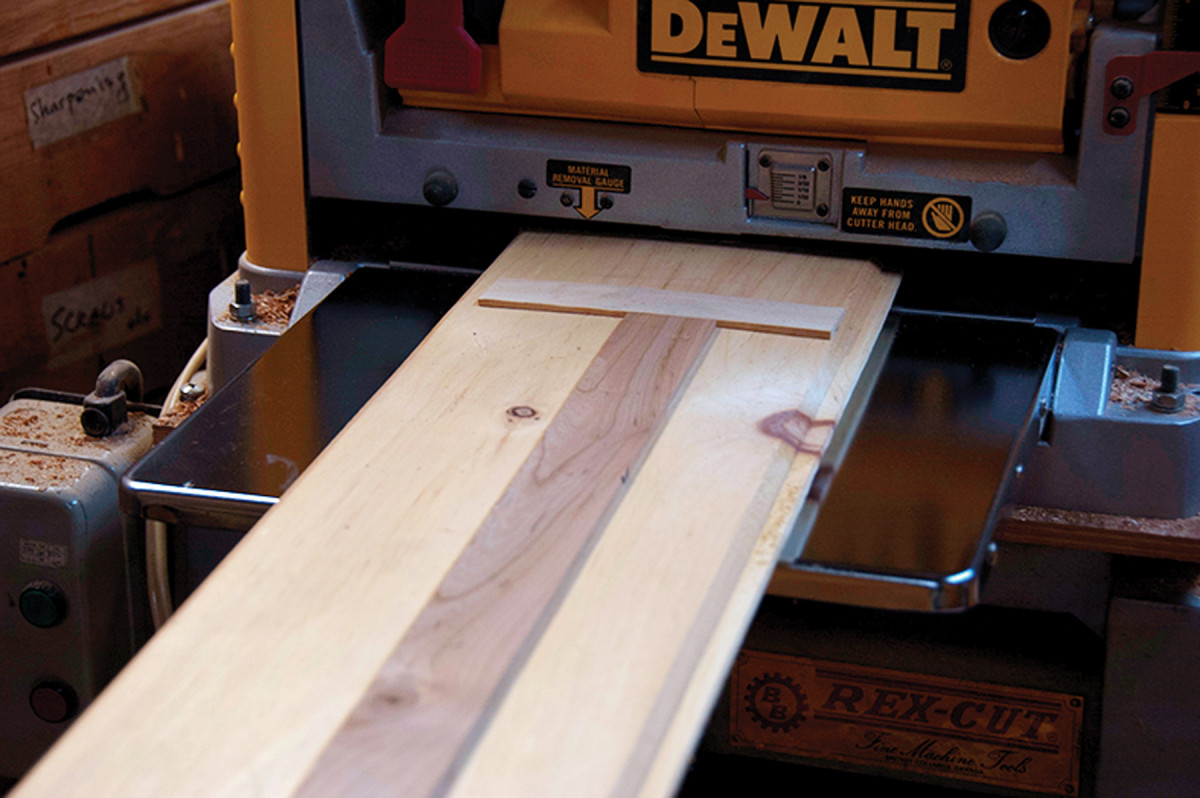
Safe planing. These narrow strips are too thin to plane without running them through the machine on a sled. Note the horizontal cleat at the leading edge for the power feed to grab.
Now take it apart and start over, this time with glue. I use Titebond III for its 10-minute open time – but don’t dawdle.
Run a bead down the center of one strip, put the next one against it and rub them together, then separate them and add glue to any dry spots.
Put the four strips plus the caul together flat, then place them as a bundle against the form, matching the center lines, and start clamping from center to ends.
When the glue is fully set, unclamp the bow. Joint one side, then run it through the planer until the two sides are smooth and parallel.
Put it back on the form to mark the center and ends, then band saw off the excess length, and drill a 1⁄8” hole at the center.
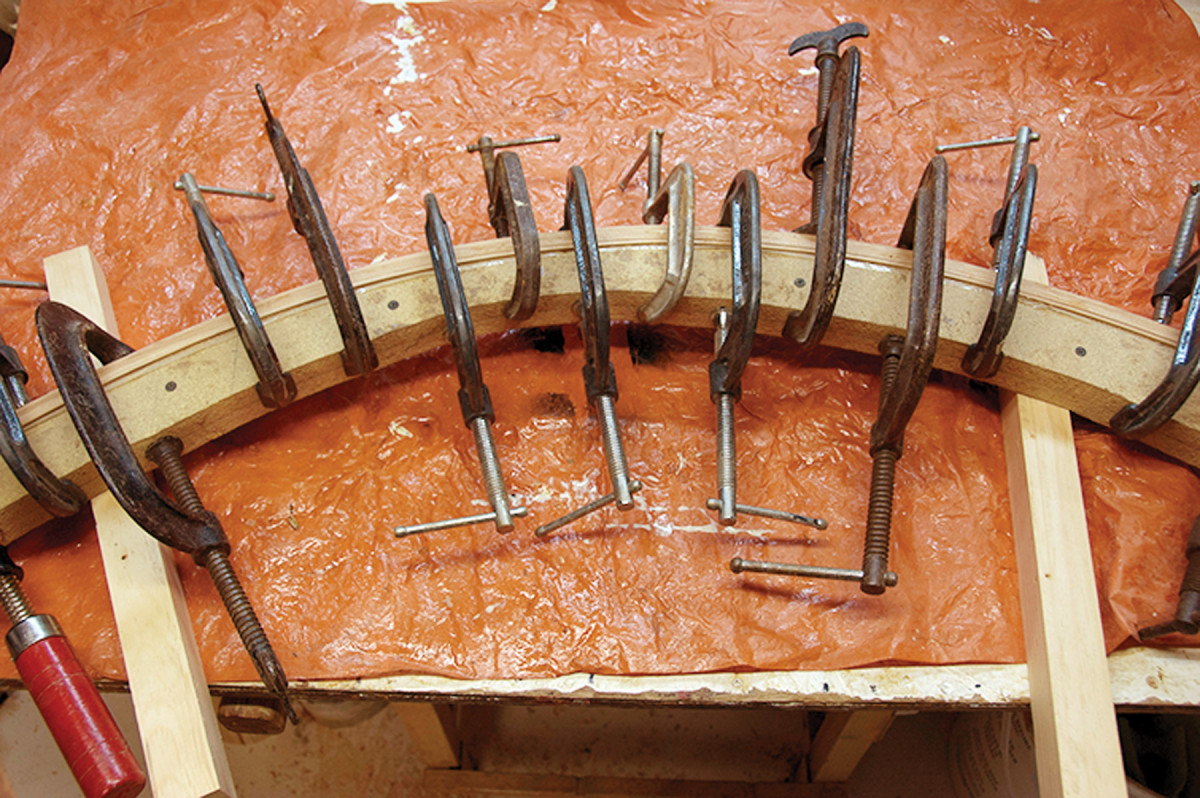
Curved & clamped. Begin clamping the four-piece lamination (plus one extra strip as a caul) at the center and work your way out toward each end.
The curve of the sides of the bow is so gentle that any smooth curve will look like any other. I marked every 2″ along the bow from the center and laid out the parabola using my spreadsheet. (Because we’re laying this out on a curved surface, it’s not technically a parabola – but the curve looks no less pleasing to my eye. If this makes no sense to you, just ignore it – you can use your eye rather than math.)
Cut the curves at the band saw, then trim the ends to length. Now smooth all the surfaces and round the edges. I do this at a shaving horse, using planes and spokeshaves before sanding all the surfaces to #150 grit.
Put it All Together
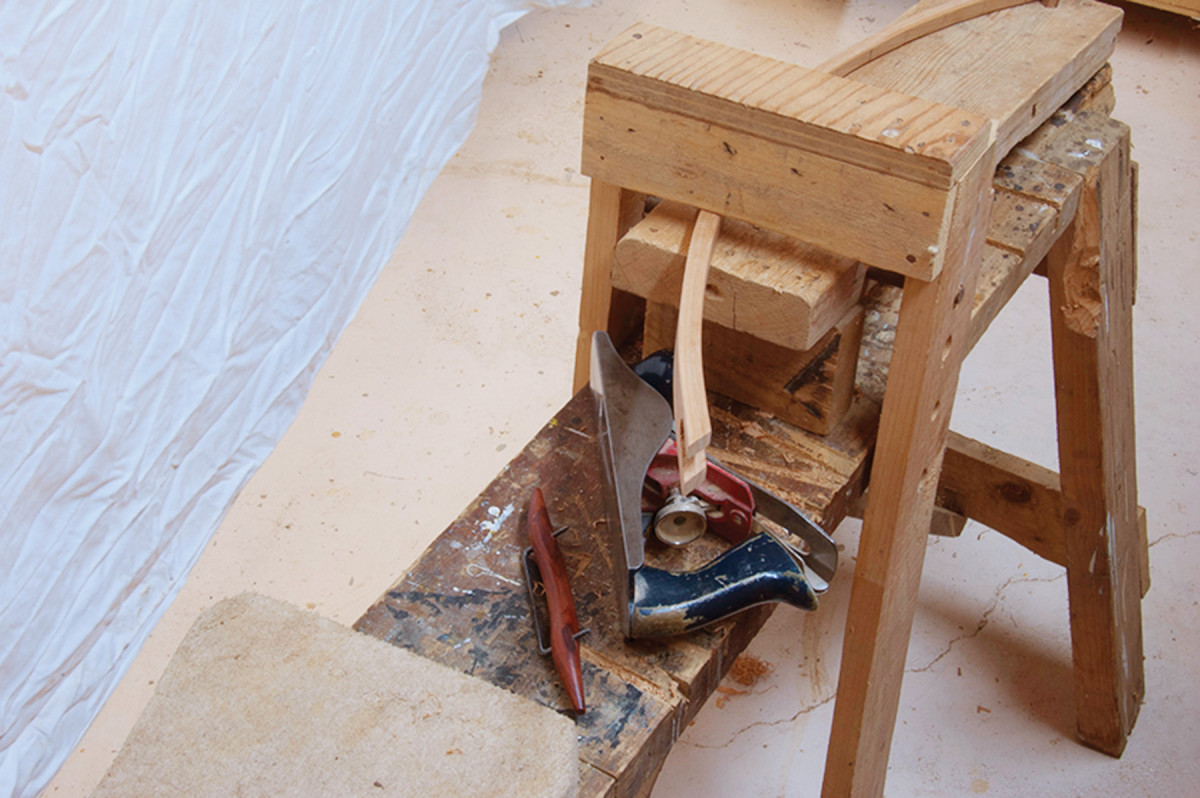
Smooth & fair. After cutting the curves on the side of the bow at the band saw, fair all the curves. I use hand tools for this operation.
Remember that overlong bit on the upright? Cut off that excess length to use as a gauge as you fit the bow and shelves to the upright. Clamp pieces of wood, as shown below right, to your bench to overcome the small amount of springback as you hold the bow at the desired length (43 5⁄8” in this case); this jig should allow the upright to fit into the bow while it holds the bow.
Scribe one end of the gauge to fit the inside curve of the bow where the upright will go.
Then use the gauge to mark the cutout on each end of the bow through which the upright will pass.
When the slots in the bow are cut (I do this with a backsaw and refine the cuts as needed with gouges and a round rasp), fit it over the upright and, with the bow held in its final position, drill a 1⁄8“-diameter hole through the bow and upright at each end.
Use 2″-long standard spiral nails as temporary pins; they slip in and out easily, and the heads are easy to grasp. Grind the points off for safety. You’ll use one of these blunted nails as a drift pin at final assembly for driving the pins in the last little bit (or for driving them out).
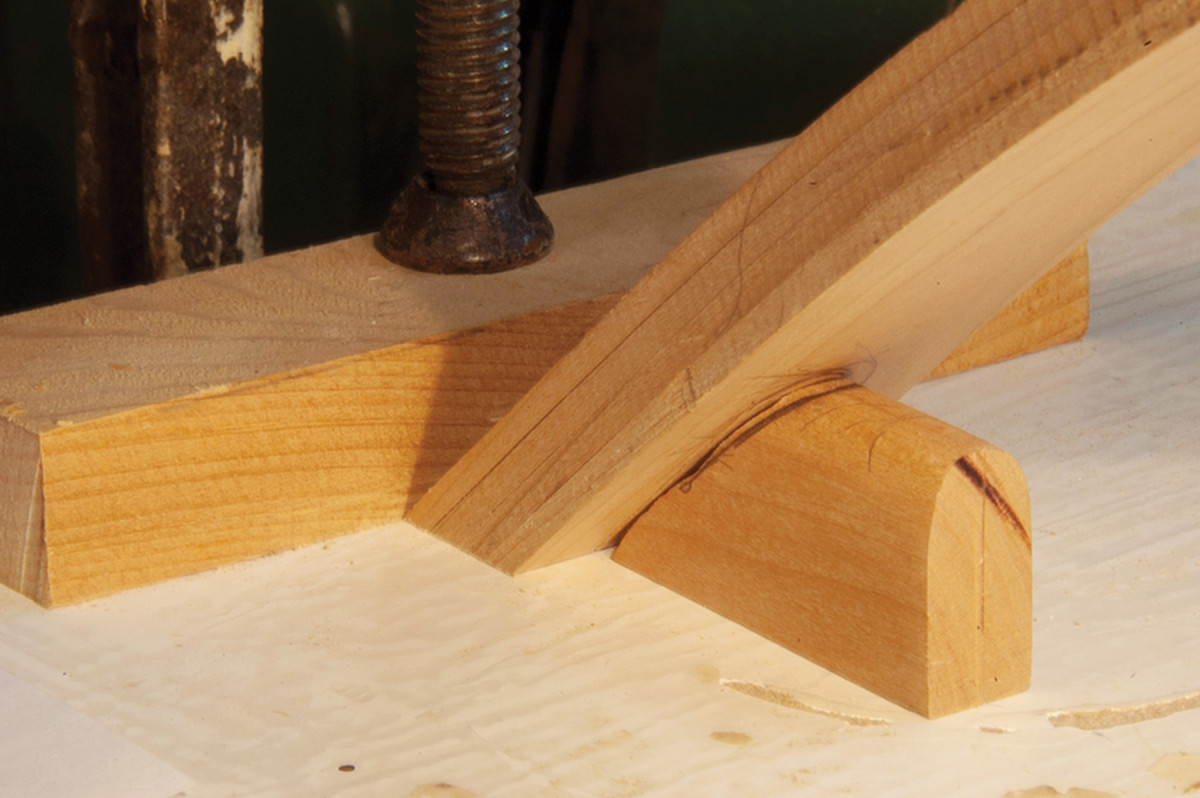
Multi-gauge. The offcut from the upright is used as a gauge at both ends of the bow, and to mark the back of each shelf, for the slots that will fit over the upright.
Mark the backs of the upright and bow to show which way they go together, and mark the top end of the bow with masking tape.
With the bow in its jig and the upright removed, use the hole drilled in the center of the bow to locate and drill a corresponding 1⁄8“-diameter x 7⁄8“-deep hole in the large shelf. The bow can touch the front of the shelf, or the shelf can be notched to fit against the bow.
Mark the spot for the pin for the other two shelves. I prefer to put it in the same place, proportionally, as on the big shelf.
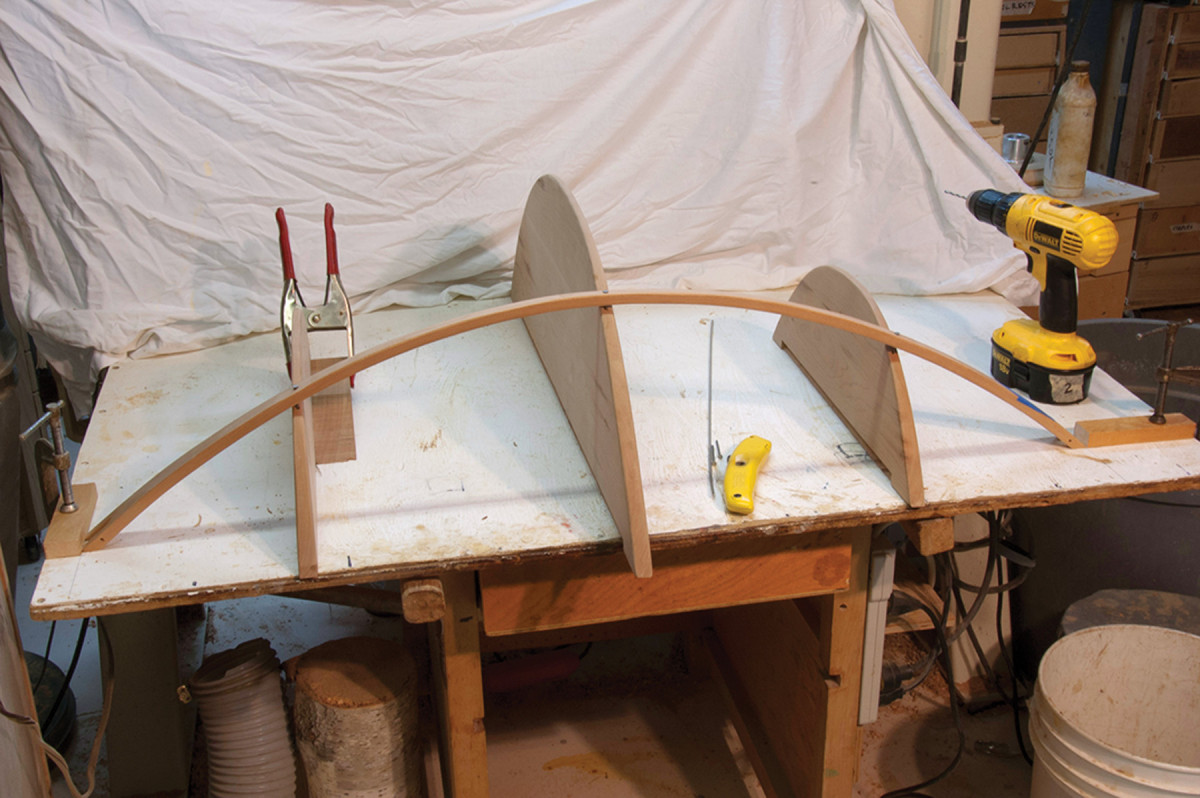
Temporarily pinned. Spiral nails hold the shelves in place to the bow after 1⁄8″-diameter holes have been drilled in both. (A jig holds the bow at the correct curve; the tape marks the top end.)
The shelf lengths used here are 193⁄4” and 32″, so use a square to find the distance from the end of the big shelf (here that’s 73⁄16“), and multiply that by the above ratio (to get 47⁄16“). Put the shelves in place and drill 1⁄8“-diameter holes through the bow, letting the drill bit’s point poke through far enough to mark the hole locations in each shelf. Pull the shelves out and drill their holes to 7⁄8” deep (or slightly deeper) as with the large shelf.
Lay out the slots in the back edge of the shelves where they meet the upright (again, use the offcut as a gauge, but now using the squared end), and cut the slots.
Next, mark the upright where the cleats meet it, and cut slots in it as shown above.
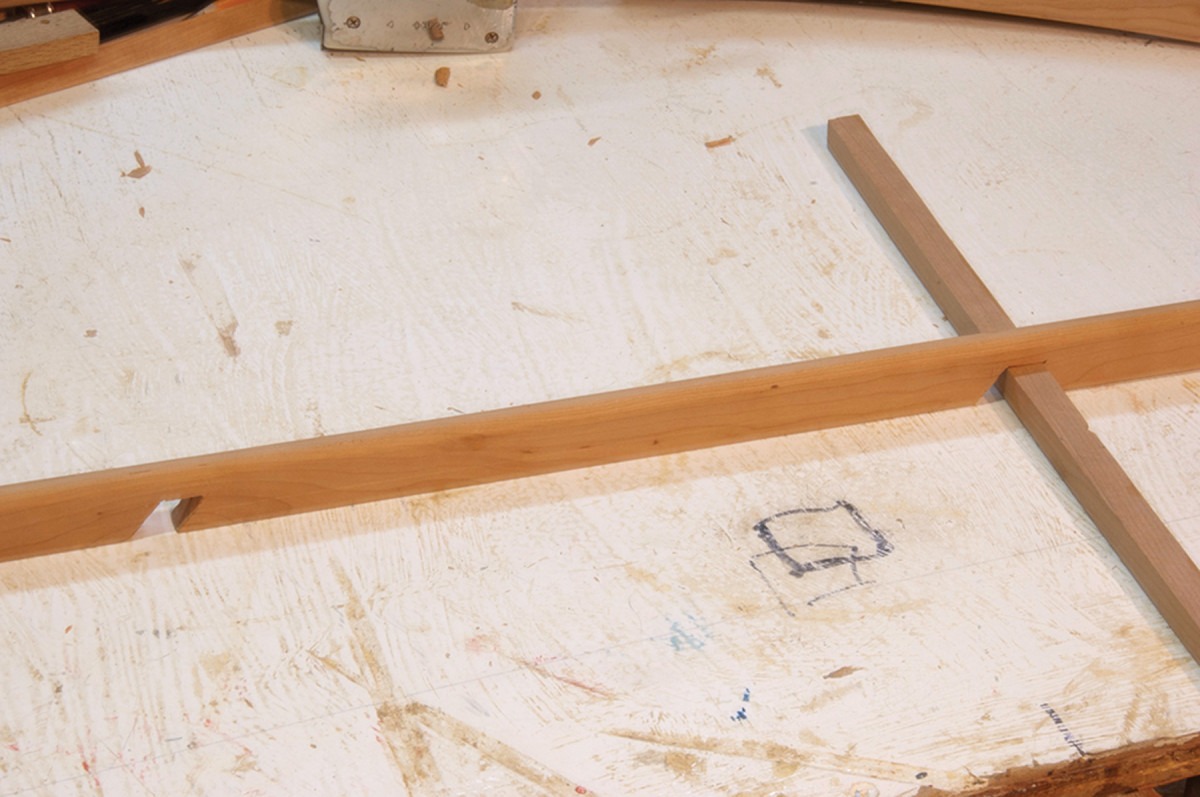
Angled slots. Cut 35° slots (to match the angle of the cleats) in the upright.
The slots must be cut at the angle of the cleat (35°); they will show underneath the shelf – but no one will ever see them without looking for them.
Write on the back of the upright the spacings between corresponding points on the notches. You’ll need those spacings when you attach the cleats to the wall.
Now dry-fit the entire assembly, again using the spiral nails, to make sure you’re satisfied with how everything goes together.
Now take it apart and apply your chosen finish. I typically use a wiping varnish to allow the natural grain and color to show.
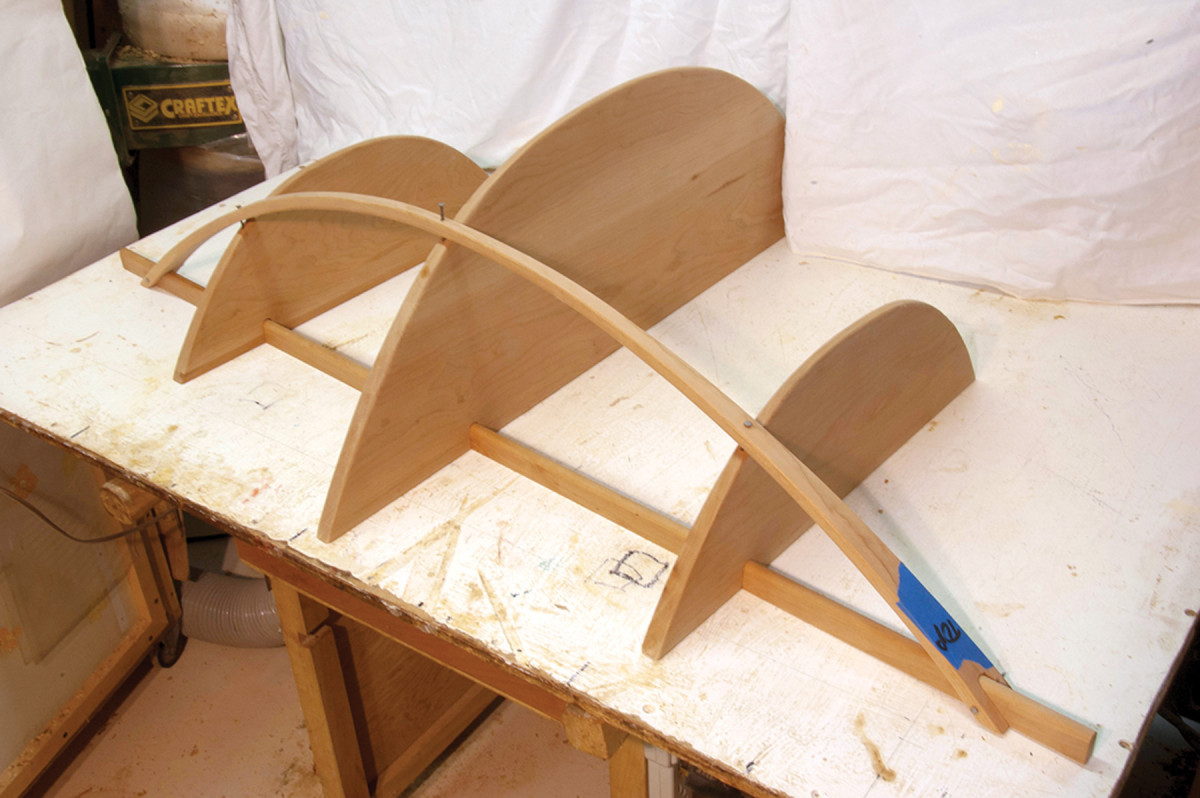
Final fitting. Before applying a finish, dry-fit the entire assembly to ensure it all goes together as planned.
Cut five 1 3⁄8“-long pieces of 1⁄8“-diameter drill rod. (That’s just short enough to not be conspicuous joining the bow to the upright.) Slightly chamfer the ends of each piece of steel.
Pin the bow to the upright, then pin the shelves to the bow. (Should you ever need to take it apart, separate the bow from the upright first, then remove the shelves from the bow.)
To securely hang your finished shelves, the cleat for the large shelf should (ideally) cross two studs.
Draw a line on the wall for the center shelf’s cleat. Draw the two other lines, spaced according to your measurements, for the smaller shelves.
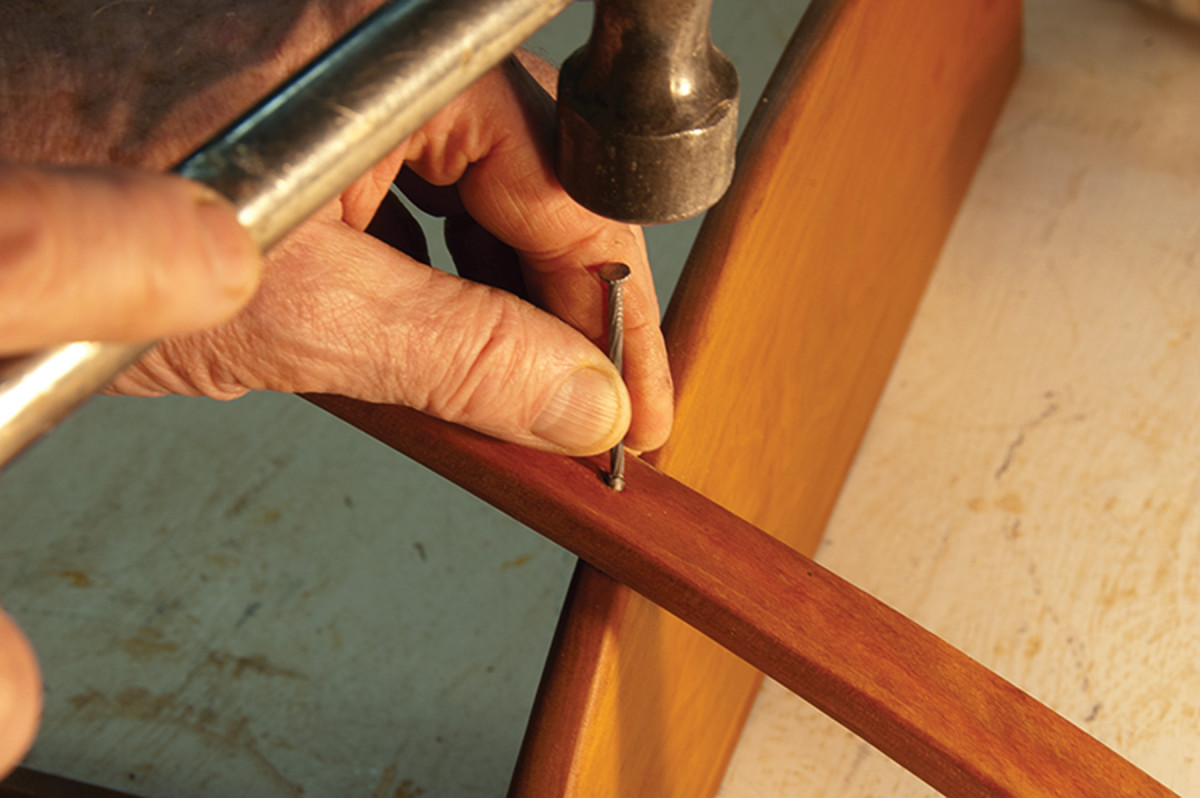
Tap it. Use one of the blunt nails as a drift pin as you tap the steel into place.
I also put lines on the cleat at the shelf opening for the upright, then draw a vertical line on the wall for one side of the upright. That and the three horizontal lines should define the cleat positions.
Drill and countersink screw holes into the cleats, then secure them to the wall.
You might need to notch the shelf parts of the cleats to go around the screws.
I rely on the stiffness of the steel pins and the friction of the shelves on the upright to hold the assembly together while I set it in place. Then I breathe again.
Here are some supplies and tools we find essential in our everyday work around the shop. We may receive a commission from sales referred by our links; however, we have carefully selected these products for their usefulness and quality.








